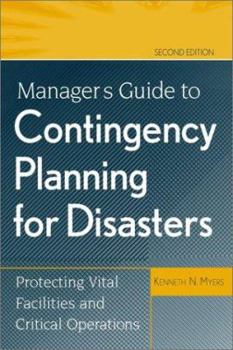Manager's Guide to Contingency Planning for Disasters: Protecting Vital Facilities and Critical Operations
With the help of an implementation strategy, guidelines for minimizing development costs, and insight into a proven plan development methodology, Manager's Guide to Contingency Planning for Disasters: Protecting Vital Facilities and Critical Operations helps you to: * Establish a corporate contingency plan policy and strategy that will ensure timely completion of a plan with minimal disruption to operations. * Minimize plan development costs * Understand the importance of conducting briefings to communicate the proper mindset before the plan development process begins. * Save time and money by avoiding the consultant's traditional approach of extensive information-gathering that contributes little to the development of practical solutions Remember that you have good people on your management team who don't need a lot of detailed instruction on how to do things in an emergency situation. Precisely "how" they do anything will depend on the specific nature of the disaster and the extent of the damage. Addressing complex hypothetical disaster combinations does not make good business sense. Just prepare "what if" strategies for a worst case and rely on the judgment of your line managers to cope with less severe incidents.
Format:Hardcover
Language:English
ISBN:047135838X
ISBN13:9780471358381
Release Date:September 1999
Publisher:Wiley
Length:256 Pages
Weight:1.50 lbs.
Dimensions:9.2" x 0.8" x 6.3"
Customer Reviews
1 rating
Sensible approach to quickly getting a plan in place
Published by Thriftbooks.com User , 24 years ago
While this book addresses contingency planning across the enterprise I found it extremely useful for a much narrower scope, which is assuring applications and systems availability, and service delivery.The book focuses on quickly developing and implementing a basic contingency plan. The approach set forth is straightforward and covers the basics of contingency planning: problem framing, impact analysis, developing the plan and testing/validating the plan. At 234 pages it is not a comprehensive text for disaster recovery or business continuity planning professionals, but for managers who see gaps or are exercising due diligence, this book covers all of the basics in sufficient detail.What I like most is the simplicity of the approach, which will give you a starting point for implementing business contingency and continuity plans quickly. Once implemented in accordance with the approach set forth in this book you will have a working plan that covers response strategies and roles and responsibilities that can be built upon and refined. The most valuable chapters in this book address telephone communications, computer processing and vital facilities, all of which are critical to business operations. Also pay careful attention to the beginning of the book because it clearly describes management's responsibility and culpability for having a viable plan in place. Also valuable are the appendices, which include case studies, sample computer contingency plan and sample business continuity strategies. These samples illustrate how these important documents should be structured.This book does not eliminate the need for professional assistance as the plan takes shape or after a baseline plan has been implemented. Indeed, prudence and due diligence should guide you to seeking the services of certified business continuity planners or disaster recovery professionals, either as consultants or in-house staff positions. However, this book does provide a starting point, especially for smaller businesses that do not have a formal plan in place.





